Bluetooth technology has been implemented in numerous consumer electronic devices (Miller 2002) and has now struck the field of Audiology. A handful of Bluetooth products are now available to patients to enhance the listening performance of current hearing systems. Bluetooth devices available on the market enable wireless transmission of sound between a mobile phone and an ear-level unit, a mobile phone and a microphone transmitter, and a microphone transmitter to an ear-level unit. This ear-level unit may be attached to an existing hearing aid or an independent device fitted directly in the ear canal. As Audiology is a field expanding rapidly with technological innovations, hearing professionals are now finding a need to educate themselves on how to effectively talk about Bluetooth in an effort to better serve their patients. This article will introduce Bluetooth terminology, giving the hearing professional an increased comfort factor when discussing and dispensing ear-level Bluetooth products.
What is Bluetooth?
Bluetooth is a communications technology designed to replace cords and wires. It is a wireless transfer of information that occurs over a secure connection at short distances, which allows devices manufactured by different companies to communicate. Bluetooth has three different classifications allowing this transmission of information to occur at various distances: Class 3 at a distance of three feet, Class 2 at a distance of 30 feet and Class 1 at a distance of 300 feet. (The Class 2 is most commonly used for rechargeable devices.) As long as both devices are within range of each other, the information transfer can occur. Bluetooth is now in over 1000 different products (Bluetooth SIG, 2006) and can be identified by the universal symbol shown in Figure 1.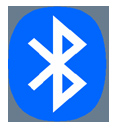
Figure 1. The universal symbol for Bluetooth
How do Bluetooth devices communicate?
Bluetooth devices communicate through a series of three different processes: Discovery, Pairing, and Connecting. Discovery enables the two devices to find each other and Paring links the devices for secure communications. Connecting is the process by which the two paired devices transfer, for our purposes, auditory information back and forth. A more in-depth discussion of pairing and connecting is provided below, as these processes impact both the hearing professional and the consumer. Lastly, Disconnection can occur and a short overview of how to fix this issued is explained.
Discovery
Discovery is the process by which each independent device is set to a findable mode where the devices can locate each other by wireless transmission in the environment. Once the devices are found in the discovery phase, the Pairing phase can begin.
Pairing
Pairing is the process of enabling devices to securely communicate with each other by uniting them with a password. Once the password is authenticated the devices are ensured to know each other in the future every time they are within range. Pairing is a process that is intended to be done one time. The pairing process between a microphone transmitter and an ear-level device, at this time, is easily accomplished in the programming software. However, the pairing process with a Bluetooth-enabled mobile phone and an ear-level device or a Bluetooth transmitter is a separate procedure performed outside the programming software. To simplify explanations, reference to Bluetooth ear-level units and transmitters with Bluetooth will be referred to as Bluetooth Earpieces.
Pairing a Bluetooth Earpiece to a mobile phone usually requires 6 steps. Remember, some mobile phones can vary in their procedure but this recipe should give a good foundation in understanding the concept. The six steps are listed below.
Pairing process between a Bluetooth earpiece and a Bluetooth mobile phone
Step 1. Ensure the mobile phone is Bluetooth-enabled
Step 2. Turn the Bluetooth Earpiece device off
Step 3. Turn the mobile phone on
Step 4. Turn the Bluetooth Power Feature in the mobile phone to "on"
Step 5. Place the Bluetooth Earpiece device into a "pairing" mode
Step 6. Engage the mobile phone to a search mode, follow the commands on the screen and enter the correct 'pass-code' when prompted.Discussion of the Pairing Process
The most important part of step one is determining if the mobile phone has Bluetooth capability (Step 1). The client will probably ask, "Does my phone have Bluetooth?" during the device selection. To determine if the mobile phone has Bluetooth technology, navigation of the mobile phone menus will be necessary. While searching the mobile phone menus look for the phrase "Bluetooth Link" as shown in Figure 2.
Below is an example of how to find the Bluetooth Link on a particular mobile phone. Once this link is found, the remaining steps in the pairing procedure can be easily accomplished. Although the menus of mobile phones will differ, complete steps should be located in the mobile phone's user manual.
Process to Find Bluetooth Link in a Motorola V551 Mobile Phone
- Select: Menu
- Select: Settings
- Select: Connection
- Bluetooth Link found
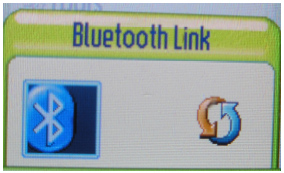
Figure 2. Screen shot of a Motorola V551 mobile phone display when finding a Bluetooth link.
Steps 2 and 3 are fairly self explanatory as you simply need to turn the devices on in order. Step 4 brings us to a new topic of Bluetooth Power. A mobile phone with Bluetooth is given a Bluetooth Power Feature that is capable of being turned on or off. Keeping the Bluetooth Power feature in the 'off' position will only allow for a temporary turn 'on' of the Bluetooth Power. With a majority of mobile phones, this means that the pairing process will be forgotten and lost by the phone when the phone itself is turned off. As the client may not adapt to this process easily, it is beneficial to get in the habit of performing this step for the pairing to remain intact even after the phone is turned 'off'. The Power Menu is located under Bluetooth Link and on some phones under the "Setup" submenu. See Figure 3.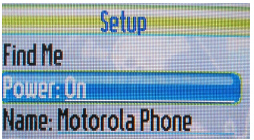
Figure 3. Screen shot of Motorola V551 mobile phone display when Bluetooth Power in the ON position.
Step 5 refers to placing the Bluetooth Earpiece in 'pairing' mode. In order for the Earpiece to be found by the mobile phone, it needs to be placed into a discoverable mode. A number or manufacturers also refer to this as the Pairing Mode. On most devices this is accomplished by pressing and holding a button down until a light starts flashing (Figure 4). Once the lights are flashing on the ear piece, the phone will be capable of "discovering" the Bluetooth Earpiece.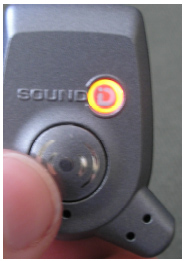
Figure 4. Example of placing a Sound ID Bluetooth earpiece into 'pairing' mode.
The final step, Step 6, is enabling the mobile phone into a search mode. This is performed by pressing 'Search for Device' or 'Look for device' on the mobile phone (Figure 5). The mobile phone will then scan the environment and list Bluetooth enabled devices on its display screen (Figure 6). Locate the correct device and select it through the mobile phone. The phone will then ask for a password (Figure 7). A majority of Bluetooth earpieces use the password of '0000'. In cases that refuse this password, verify the password with the manufacturer's instruction booklet.
Figure 5. Example of selecting "Look for Devices" to launch search mode on mobile phone.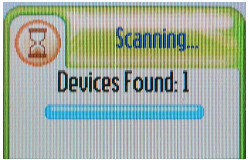
Figure 6. Example of mobile phone scanning the environment for Bluetooth devices.
Figure 7. Example of mobile phone prompt for password entry.
Connecting
After the devices are paired they enter into a connected state. This is where they are actively communicating with each other and, for our purposes, sending auditory information back and forth. Unlike pairing, connecting is something done on a regular basis. Connecting is accomplished by turning on the mobile phone first and subsequently turning on the Bluetooth earpiece. The mobile phone acts as the "master" of the relationship (Morrow, 2002), and connection only occurs if it is turned on first.
Once the devices are turned on in the proper order, a light on the earpiece may flash. The flashing indicates that the earpiece is searching for its paired partner and verifying the password. Once connected, the phone may give confirmation that connection has been made. A Bluetooth symbol may appear on the phone and/or a message stating "connected to name of intended device" (Figure 8). Once communication is established you should also be aware of circumstances that would result in the devices becoming disconnected.
Figure 8. Example of mobile phone displaying the Bluetooth symbol when connected to a Bluetooth earpiece.
Disconnection
At some point in time, the devices may disconnect from each other. Disconnection occurs when one or both of the devices are turned 'off' or move out of the designated operating range. Reconnection can be accomplished in various ways. If both devices are in the 'off' position, turn the products 'on' in the proper order, mobile phone first. Devices that are out of range with each other can reconnect by coming back into the specified range within a short time period, usually less than 90 seconds. If the devices are out of range for longer than 90 seconds, the easiest way to reestablish connection is to turn the earpiece 'off' and then back 'on'.
Clinical Considerations
The fitting procedure for Bluetooth devices will vary depending on the particular product. Every product, however, will go through the connecting and pairing procedure for communication between the devices to be established. Pairing can be performed at any time during the fitting session, but it may be most helpful to perform this step early in the orientation process so the patient can practice making and receiving phone calls during the counseling session. The goal is to help the client feel comfortable and confident using this wireless technology.
During the orientation appointment, a bulk of the time should be spent counseling on the connection of Bluetooth devices (see Patient counseling suggestions below). The client will be using the connection procedure, in most cases, on a daily basis. Making sure the client is comfortable with this procedure will minimize return visits.
Patient counseling suggestions
- Explain connection procedure
- How to connect
- Range of communication
- Disconnection
- How to reconnect
- Practice connecting devices
- Have client receive a phone call
- Have client make a phone call
Summary
Bluetooth devices have been gaining in popularity over the past couple of years, with the number of Bluetooth-enabled product shipments more than doubling from 2004 to 2005 (MarketResearch.com, 2005). The projections indicate the trend to continue this year. It is only a matter of time before we see more hearing impaired clients requesting Bluetooth technology. Current Bluetooth products on the market give the Hearing Professional more options to offer existing clients, as well as a way to attract new patients to the practice.
For more information, visit www.soundid.com
References
Buletooth SIG (2006). Bluetooth Basics. Retrieved on 7/7/2006 from www.bluetooth.com/bluetooth/learn/basics
MarketResearch.com (2005). Bluetooth 2005: The Future is Here. Retrieved 7/7/06 from www.marketresearch.com/product/display.asp?productid=1170669&SID=66406891-362801000-376090243&kw=bluetooth
Miller, B.A. (2002), Bluetooth Revealed: The Insider's guide to an open specification for global wireless communications. Prentice Hall, NJ.
Morrow, R. (2002). Bluetooth operation and use. McGraw-Hill Telecom, NY.
